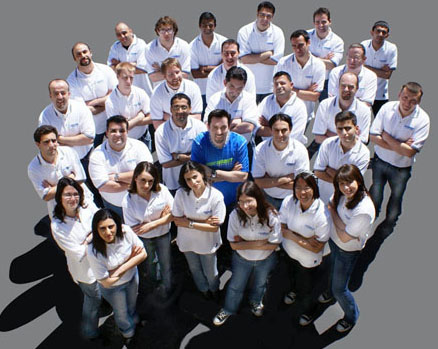HISTORY OF TRANSDANUBIAN RESEARCH INSTITUTE
3. Summary
The Transdanubian Research Institute is unique in many ways. Unique, as its activity and directions of research are extremely diverse. There worked and still are actively working geographers, climate scientists, economists, lawyers, sociologists, environmental scientists, political scientists, ethnographers, historians, linguists, agricultural researchers, each of them researching Pannonian landscape from their own point of view. For a long time (about until the early '70s) these researches carried out within the framework of the Institute were keeping their independence, their own identity, all the professionals of the Institute were free to work on their own research topic, the results of which have survived in the form of articles and books for the posterity. The result was a kind of specialization within the institution, which " created a separate "image" within the institution and outside for everyone. The disciplines themselves also specialized and it was often the case that a part of a new discipline developed into a new, independent discipline working with its own methods.
However, in addition to this differentiation, a process of integration also could be observed. The dividing boundaries between several independent sciences had begun to blur. To establish causal relationship more fully and in a more exact way disciplines started to collaborate and work in an alliance. Beyond specialization, the emerging cooperation and complexity of sciences during the examination of special problems is the other main feature of the science development of our age.
This complexity emerged not only in natural or social sciences, but also between them. Especially those sciences developed into a complex science, taken the results from other disciplines or in conjunction with other sciences, which had regional perspective. Regional research institutes and science do everything so precisely because they are spatial research institutions. Regional research institutes, therefore promoted primarily the development of the complexity íand the process of integration of science. This is shown in the Transdanubian Research Institute's profile of sciences. This is why the Institute's researchers of physical geography were investigating geology, soil chemistry, plant geography, climatology and hydrology in addition to geography, and historians use the results and apply the methods of geology, agronomy, engineering, economics, sociology, ethnographic studies and philosophy. Because changes in one component entail changes in the other component as well.
Only the German regional research institutions were characterized by serving for the daily politics. The French, Russian, English regional research was originally initiated for completely different purposes. They were striving for decentralization against the excessive centralization which inordinately increased the role of capital, promoting the development of rural areas, rural economic, administrative and cultural centers, and districts respectively.
All these regional researches were carried out in seminars, institutes operating under university departments or in councils, committees and study groups set up specifically for this purpose. As the Eastern European scientific institutes wanted to ward off the attack of the German ideology in the field of science at the beginning resembled to the German regional research institutes. These institutes after 1945 more or less preserved this profile but in their activities regional issues came up to the forefront, by the workout of which they served for regional planning and organization. This feature characterised the Baltic Institute of Torun in Poland, the Silesian Institute in Wroclav, the Western Institute in Poznań, the Czech Silesia Institute in Opava and the Transdanubian Research Institute in Hungary as well. In terms of the development of science they were moving towards complexity from specialization.
This "complexity" process of the mid-70s also emerged in the Transdanubian Research Institute. In order to meet the new goals its research profile was reorganized and as a "by-product" of this researches of history, ethnography, cultural history were pushed into the background, or lost their past self-identity within the Institute. From this period onward few self-published works were issued in these scientific areas of the Institute. In the late 1980s the researches increasingly oriented towards the major European regions from Hungarian territories, giving main emphasis to space economy, spatial planning, rural development, enterprise development, employment problems, in which their human dimensions were manifested in living conditions and quality of life. As an addition to these a special issue is to study how culture can foster the development of cities, how and in what ways can culture enforced urban development functions and how those "cultural cities" operate where the city's development plays an important role in culture.
Due to all these reasons, this historical overview and the description of research topics and the timely reviewing of the details was selective. First, it sought to focus on what were the most important moments in the Institute's life where in a relatively direct way TRI could play a role in the academic and cultural life of Transdanubia and Pécs.
LITERATURE
-
BABICS András: A Magyar Tudományos Akadémia Dunántúli Tudományos Intézetének huszonöt éve 1943–1968. – Az MTA II. Osztályának Közleményei, 1968. 17. 55–95. p.
-
HORVÁTH Gyula (szerk.): A Dunántúli Tudományos Intézet 50 éve. In: A Dunántúl szolgálatában. Előadások Rúzsás Lajos emlékének. Pécs: MTA Regionális Kutatások Központja, Magyar Történelmi Társulat Dél-dunántúli Csoportja, 1995. 9–34. p.
-
RÚZSÁS Lajos: A Magyar Tudományos Akadémia Dunántúli Tudományos Intézetének húsz éve és a regionális kutatás. In: Értekezések 1963. Szerk.: Babics A. Akadémiai Kiadó, 1964. 11–31. p.
-
SZABÓ Pál Zoltán: A Dunántúli Tudományos Intézet és az újjáépülő Dunánúl. Pécs: Kultúra Könyvnyomdai Műintézet, 1945.

 The Past
The Past Directors
Directors Researches
Researches Publications
Publications Staff
Staff Photo albums
Photo albums Timeline
Timeline Magyarul
Magyarul
